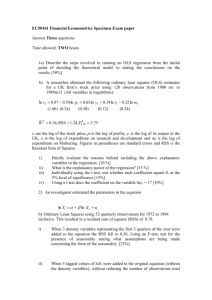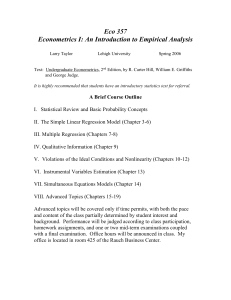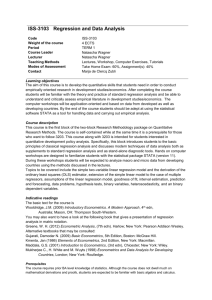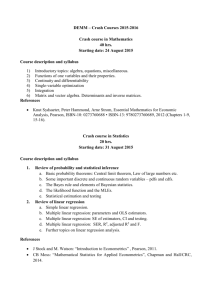Introductory Econometrics - The College of New Jersey
advertisement
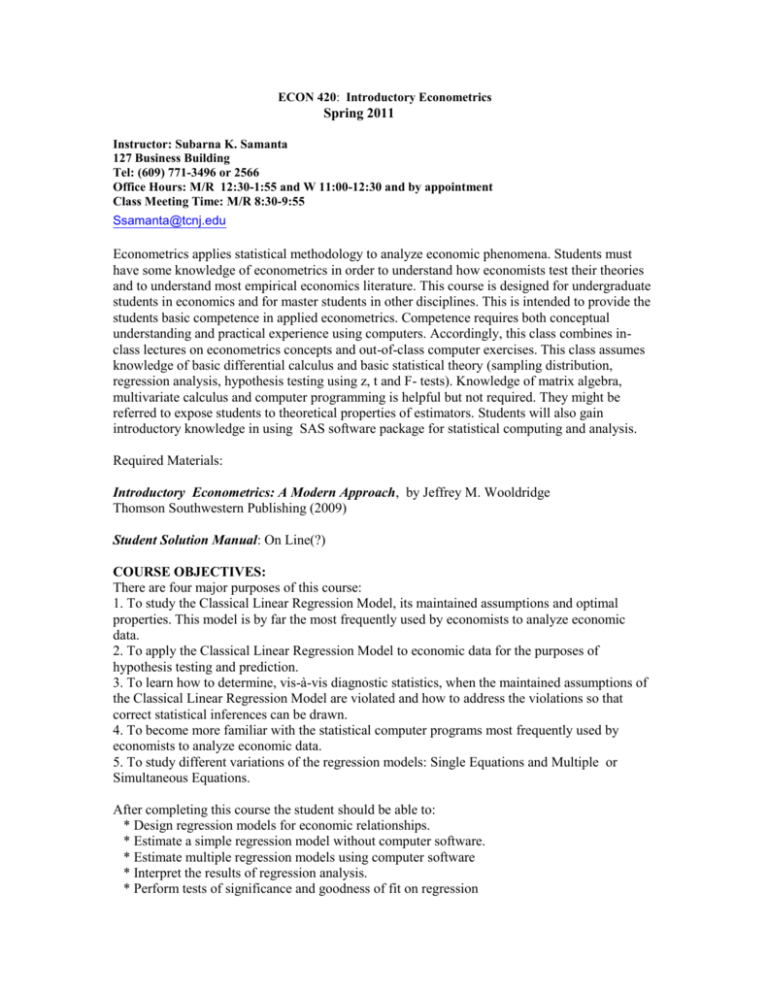
ECON 420: Introductory Econometrics Spring 2011 Instructor: Subarna K. Samanta 127 Business Building Tel: (609) 771-3496 or 2566 Office Hours: M/R 12:30-1:55 and W 11:00-12:30 and by appointment Class Meeting Time: M/R 8:30-9:55 Ssamanta@tcnj.edu Econometrics applies statistical methodology to analyze economic phenomena. Students must have some knowledge of econometrics in order to understand how economists test their theories and to understand most empirical economics literature. This course is designed for undergraduate students in economics and for master students in other disciplines. This is intended to provide the students basic competence in applied econometrics. Competence requires both conceptual understanding and practical experience using computers. Accordingly, this class combines inclass lectures on econometrics concepts and out-of-class computer exercises. This class assumes knowledge of basic differential calculus and basic statistical theory (sampling distribution, regression analysis, hypothesis testing using z, t and F- tests). Knowledge of matrix algebra, multivariate calculus and computer programming is helpful but not required. They might be referred to expose students to theoretical properties of estimators. Students will also gain introductory knowledge in using SAS software package for statistical computing and analysis. Required Materials: Introductory Econometrics: A Modern Approach, by Jeffrey M. Wooldridge Thomson Southwestern Publishing (2009) Student Solution Manual: On Line(?) COURSE OBJECTIVES: There are four major purposes of this course: 1. To study the Classical Linear Regression Model, its maintained assumptions and optimal properties. This model is by far the most frequently used by economists to analyze economic data. 2. To apply the Classical Linear Regression Model to economic data for the purposes of hypothesis testing and prediction. 3. To learn how to determine, vis-à-vis diagnostic statistics, when the maintained assumptions of the Classical Linear Regression Model are violated and how to address the violations so that correct statistical inferences can be drawn. 4. To become more familiar with the statistical computer programs most frequently used by economists to analyze economic data. 5. To study different variations of the regression models: Single Equations and Multiple or Simultaneous Equations. After completing this course the student should be able to: * Design regression models for economic relationships. * Estimate a simple regression model without computer software. * Estimate multiple regression models using computer software * Interpret the results of regression analysis. * Perform tests of significance and goodness of fit on regression models. * Explain, detect, and correct for the major problems encountered in regression analysis. * Understand the statistical and theoretical underpinnings of the techniques used. * Apply the course techniques to research problems. METHODOLOGY: The course is taught using a combination of lecture and group or individual exercises. Lectures will sometimes provide more proof and derivation than the text includes so that students may understand why they should use certain estimation techniques. A good theoretical foundation for the techniques used allows students to build upon the knowledge gathered in this course. Homework problem sets are assigned to prepare students for tests. A number of the homework assignments are the required stages of a research project of the student's choice. The research project is done individually, but you can consult your colleagues This project allows students to gain an appreciation for the kinds of problems that applied researchers encounter and the decisions they must make. The lowest non-project homework grade will be dropped before averaging. Requirements and Grading: This course provides four credit hours of instruction. Students are reminded of their obligations: attending class, doing the homework assignments and taking the quizzes and exams in time. The homework assignments are typically the end of the chapter problems using the data available on the webpage of the author, or the data supplied by the instructor. This course will have a midterm and a final exam. Course grade will be based on the quizzes (15%), the midterm examination (30%), the final examination (35%) and class participation (5%) and a research paper(15%). Quizzes may come from homework assignments. A weighted average is taken for the final letter grades, not the raw numerical scores, of all components of the course. CLASS PARTICIPATION: Class participation involves being in class, participating in group or individual in-class exercises, and contributing to class discussion. All of these things will help you to do well on the homework and tests. In addition, I will count your participation about 5 percent of the grade. Attendance is highly recommended. I will note attendance patterns, and excessive absence (more than 4 or 5 begins to be excessive) will detract from your participation grade. Students are expected to know everything that happens in class including any announcements of changed deadlines or test dates. MAKE-UP TESTS AND LATE ASSIGNMENTS: If you must miss a test or have extraordinary reasons for being late with an assignment you must clear it with me no later than one day after the due date or the grade will be zero. Makeup test will only be allowed for valid reasons such as sickness, unexpected mishap etc. If you miss a quiz, you will lose the portion of the credit assigned to it. There is no make-up for quizzes. POLICY ON CHEATING: I expect academic honesty from students at all times. Cheating, as defined in the Student Handbook, will result in a grade of zero for the assignment involved. On homework assignments, I do not object to students working together as long as both are contributing and homework papers do not look like identical copies. Our appropriate sequence of coverage follows. Any change will be announced in class, as we go along. I. An Overview of the Course and Econometrics Class Discussion a. What Econometricians Do – Some Examples b. The Nature of your Textbook Data Types Used in Econometrics Chapter 1 a. Cross-Section Data b. Time-Series Data c. Pooled Cross-Section and Time-Series Data d. Varying Cross-Sections e. Panel Data II. A Brief Introduction to SAS (Statistical Analysis System) a. The Layout of a Typical SAS Program i. The Data Step, ii. The Procedure Step b. Execution of a SAS Program i. Program File, ii. Log File, iii. Listing File III. Review of Basic Statistics a. Sampling Distribution and Statistical Inferences b. Estimation and properties of Estimators c. Testing of Hypothesis (z, t, Chi-square and F tests) d. And p – value approach IV. Review of Ordinary Least Squares a. Mechanics of Ordinary Least Squares b. Algebraic Properties of Ordinary Least Squares c. Statistical Properties of Ordinary Least Squares d. The Gauss-Markov Theorem (BLU) e. The Rao-Blackwell Theorem (MVU) V. Multiple Regression Analysis: a. Estimation, Inference, Extensions with Other issues: such as Functional Forms, Selection of Regressors b. Binary Variables, Linear Probability Model etc. c. Testing of Hypotheses Discussion Appendix B & C Chapter 2 Chapter 3,4, 6 and 7 VI. Heteroskedasticity Chapter 8, Discussion and Handouts a. Consequences of Heteroskedasticity b. Testing for Heteroskedasticity (Goldfield-Quandt, Breusch-Pagan, and White tests) c. White’s method for correction for heteroskedasticity and the Generalized least squares estimators d. Correction for Heteroskedasticity using Weighted Least Squares Estimation, or Feasible Weighted Least Squares Estimation. VII. Regression Analysis with Time-Series Data Chapter 10, 12 and Handouts a. Autoregressions and serially correlated error problems (Durbin Watson test and Durbin h test) b. Correction for Serial Correlation with Strictly Exogenous Regressors c. Cochran-Orcutt method for correcting autocorrelation d. Autoregressive models and the selection of lag length e. R-square and Adjusted R-square and AIC, BIC criteria f. Spurious Regression Analysis and the Granger Causality test g. Trend and Seasonality (Random Walk Models with Drift, Stochastic Trend) h. Non-Stationarity and the Order of Integration (Dickey-Fuller test and Augmented DickeyFuller test for non-stationarity) i. Converting Non-Stationary Data into Stationary Data j. Co-integrations among the Variables and the Long Run Equilibrium Relation VIII. Regression with Binary Dependent Variable a. Linear Probability Model b. Probit Model and Logit Model IX. Regression with Panel Data a. Example of two time periods b. Fixed Effect Regression c. Regression with Time Fixed Effects Chapter 17 Chapter 13 X. Simultaneous Equation Models Chapter 15, 16 and discussions a. Simultaneity Bias in OLS b. Identifying and Estimating a Structural Equation c. Systems with more than Two Equations d. Instrumental Variable Estimation e. Two Stage Least Squares and Maximum Likelihood Estimation g. Simultaneous Equations Model i. Macroeconomic Models Interaction with the instructor in class is encouraged. Do not hesitate to seek clarifications of material. Your responses to questions dealing with the subject matter, coupled with your attendance record, will form the basis of the class participation portion of your grade. In each class, homework assignment will be given. On occasions, you will be required to submit solutions of these problems, with one week's notice. I will explain solutions in the class or post them on my office door. There will be quizzes, of five to ten minutes duration, at the beginning of some classes. These quizzes may be given without prior announcement. When preparing for class test and final exam, it is important that you study both the homework problems and the problems covered in the class. Do not forget to review your notes! Make sure you have a good calculator for the test. Grading is on a curve based on total points: A 93 and up B- 79-82 D+ 66-68 A- 89-92 C+ 76-78 D 60-65 + B 86-88 C 73-75 F 59 and below B 83-85 C- 69-72 The Structure of the Empirical Project 1. Getting Started Choose a research question. The question may concern an industry, a profession, or any social or economic problem that interests you. In general, ask yourself which theoretical relationships that you have studied would be worth investigating. For example, in business, economics students may choose to analyze money demand, the determinants of inflation or GDP. Finance students might estimate beta or the determinants of dividends. Marketing students might analyze advertising expenditures or sales 2. Literature Review After choosing a topic and formulating a research question, you need to determine what other researchers have done on that topic. This bibliographic search is crucial because existing research on your topic will show how models have been formulated and estimated, and the data sources that are available. Commonly used databases for journal articles include: PsycInfo (Psychology), EconLit (Economics), ABI/Inform Global (Business), EbscoHost (General). All are available at the library website. Using the literature review, you should construct your own model. The initial model will be in broad terms and will identify the dependent and independent variables for which you would like to collect data. 3. The Proposal Prepare a proposal that explains why you believe that independent variables you have chosen are likely to be associated with the dependent variable. Describe the hypothesis you plan to test and the expected nature of the effects of the independent variables. In particular, discuss the expected signs of the regression coefficients, whether non-linear relations might be present, what kind of interactions among independent variables you should look for and so on. 4. Data Collection Data collection is tedious. Unfortunately, it is also unavoidable. Generally speaking, more degrees of freedom and hence more observations lead to better estimations. Be sure that you have at least 30 degrees of freedom. For data sources, you should consult the reference librarian or the instructor. You may also want to try an internet search of the sources listed in the resource section below . 5. Model Estimation and Interpretation of Results Estimate the model and make a thorough investigation of the statistical results. A fundamental lesson here is to avoid hasty conclusions without subjecting the model to more analysis. Check for correlations among explanatory variables, serial correlations among the random errors terms, heteroskedasticity, residual analysis etc. before drawing any conclusion about your model. 6. Conclusions 7. References Writing the Paper Pay close attention to the clarity of your writing. The quality of your writing will determine a significant portion of your grade. Be sure that your sentences are coherent and that each paragraph follows from the previous paragraph. Use a consistent method to show your references (including data sources). Either MLA or APA is fine. A good way to avoid a poorly written paper is to take a look at a manual of style (see The Writing of Economics by Donald N. McCloskey or The Elements of Style by William Strunk and E. B. White). A suggested outline of the paper is like: I. Statement of the problem, II. Review of Literature, III. Formulation of a Model , IV. Data Sources and Description, V. Model Estimation and Hypothesis Testing, V1. Interpretation of the Results and Conclusions and VII. References RESOURCES Data Sources: International Financial Statistics, United Nations Statistical Yearbook, World Development Report Economic Report of the President, Statistical Abstract of the United States, Survey of Current Business Business Conditions Digest Web resources: Economic Report of the President, annual. Washington DC:US GPO http://w3.access.gpo.gov/eop/ The White House Economics Statistics Briefing Room http://www.whitehouse.gov/fsbr/esbr.html Federal Reserve Bank Economic Data http://research.stlouisfed.org/fred2/ Federal Reserve Board Data releases and historical data http://www.federalreserve.gov/releases/ NJ Department of Labor http://www.nj.gov/labor/lra/ US Bureau of Economic Analysis http://bea.doc.gov/ US Bureau of Labor Statistics http://stats.bls.gov US Census Bureau (includes US Statistical Abstract) http://www.census.gov Conference Board (including leading indicators) http://www.conference-board.org/economics/ International Statistical Data Locators and Links http://www.ntu.edu.sg/library/statdata.htm International Monetary Fund http://www.imf.org/ Organization for Economic Cooperation and Development http://www.oecd.org World Trade Organization http://www.wto.org/ US International Trade Commission http://www.usitc.gov/ The World Bank (includes World Development Report) http://www.worldbank.org/

